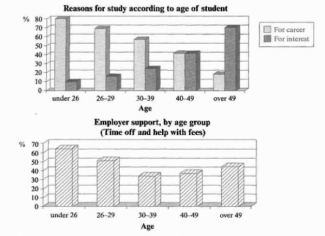The charts below shows the main reasons for study among students of differen age groups and the amount of support they received from employers.
Summarise the information by selecting and reporting the main features, and make comparisons where relevant.

The first graph shows that there is a gradual decrease in study for career reasons with age. Nearly 80% of students under 26 years, study for their career. This percentage gradually declines by 10-20% every decade. Only 40% of 40-49 years olds and 18% of over 29 year olds are studying for career reasons in late adulthood.
Conversely, the first graph also shows that study stemming from interest increases with age. There are only 10% of under 26 years olds studying out of interest. The percentage increases slowly till the beginning of the fourth decade, and increases dramatically in late adulthood. Nearly same number of 40-49 years olds study for interest in comparison to 18% studying for career reasons in that age group. The second graph shows that employer support is maximum (approximately 60%) for the under 26 years students. It drops rapidly to 32% up to the third decade of life, and then increases in late adulthood up to about 44%. It is unclear whether employer support is only for career-focuced study, but the highest level is for those students who mainly study for career purposes.

Grammar and spelling errors:
Line 2, column 64, Rule ID: WHITESPACE_RULE
Message: Possible typo: you repeated a whitespace
Suggestion:
...raph also shows that study stemming from interest increases with age. There are o...
^^
Line 2, column 538, Rule ID: WHITESPACE_RULE
Message: Possible typo: you repeated a whitespace
Suggestion:
... years students. It drops rapidly to 32% up to the third decade of life, and then...
^^
Transition Words or Phrases used:
also, but, conversely, first, if, second, so, then, third
Attributes: Values AverageValues Percentages(Values/AverageValues)% => Comments
Performance on Part of Speech:
To be verbs : 7.0 7.0 100% => OK
Auxiliary verbs: 0.0 1.00243902439 0% => OK
Conjunction : 4.0 6.8 59% => More conjunction wanted.
Relative clauses : 5.0 3.15609756098 158% => OK
Pronoun: 9.0 5.60731707317 161% => Less pronouns wanted
Preposition: 30.0 33.7804878049 89% => OK
Nominalization: 0.0 3.97073170732 0% => More nominalizations (nouns with a suffix like: tion ment ence ance) wanted.
Performance on vocabulary words:
No of characters: 917.0 965.302439024 95% => OK
No of words: 187.0 196.424390244 95% => OK
Chars per words: 4.90374331551 4.92477711251 100% => OK
Fourth root words length: 3.69794460899 3.73543355544 99% => OK
Word Length SD: 2.49047486244 2.65546596893 94% => OK
Unique words: 99.0 106.607317073 93% => More unique words wanted.
Unique words percentage: 0.529411764706 0.547539520022 97% => OK
syllable_count: 267.3 283.868780488 94% => OK
avg_syllables_per_word: 1.4 1.45097560976 96% => OK
A sentence (or a clause, phrase) starts by:
Pronoun: 3.0 1.53170731707 196% => OK
Interrogative: 0.0 0.114634146341 0% => OK
Article: 4.0 4.33902439024 92% => OK
Subordination: 0.0 1.07073170732 0% => More adverbial clause wanted.
Conjunction: 3.0 0.482926829268 621% => Less conjunction wanted as sentence beginning.
Preposition: 0.0 3.36585365854 0% => More preposition wanted as sentence beginning.
Performance on sentences:
How many sentences: 11.0 8.94146341463 123% => OK
Sentence length: 17.0 22.4926829268 76% => The Avg. Sentence Length is relatively short.
Sentence length SD: 27.7497673283 43.030603864 64% => OK
Chars per sentence: 83.3636363636 112.824112599 74% => OK
Words per sentence: 17.0 22.9334400587 74% => OK
Discourse Markers: 5.18181818182 5.23603664747 99% => OK
Paragraphs: 2.0 3.83414634146 52% => More paragraphs wanted.
Language errors: 2.0 1.69756097561 118% => OK
Sentences with positive sentiment : 5.0 3.70975609756 135% => OK
Sentences with negative sentiment : 0.0 1.13902439024 0% => More negative sentences wanted.
Sentences with neutral sentiment: 6.0 4.09268292683 147% => OK
What are sentences with positive/Negative/neutral sentiment?
Coherence and Cohesion:
Essay topic to essay body coherence: 0.198202339077 0.215688989381 92% => OK
Sentence topic coherence: 0.0841399149264 0.103423049105 81% => OK
Sentence topic coherence SD: 0.0688927576002 0.0843802449381 82% => OK
Paragraph topic coherence: 0.167530455145 0.15604864568 107% => OK
Paragraph topic coherence SD: 0.0311407626309 0.0819641961636 38% => Paragraphs are similar to each other. Some content may get duplicated or it is not exactly right on the topic.
Essay readability:
automated_readability_index: 10.1 13.2329268293 76% => Automated_readability_index is low.
flesch_reading_ease: 71.14 61.2550243902 116% => OK
smog_index: 3.1 6.51609756098 48% => Smog_index is low.
flesch_kincaid_grade: 7.6 10.3012195122 74% => OK
coleman_liau_index: 10.84 11.4140731707 95% => OK
dale_chall_readability_score: 7.52 8.06136585366 93% => OK
difficult_words: 36.0 40.7170731707 88% => OK
linsear_write_formula: 6.5 11.4329268293 57% => Linsear_write_formula is low.
gunning_fog: 8.8 10.9970731707 80% => OK
text_standard: 8.0 11.0658536585 72% => OK
What are above readability scores?
---------------------
Rates: 56.1797752809 out of 100
Scores by essay e-grader: 5.0 Out of 9
---------------------
Note: the e-grader does NOT examine the meaning of words and ideas. VIP users will receive further evaluations by advanced module of e-grader and human graders.